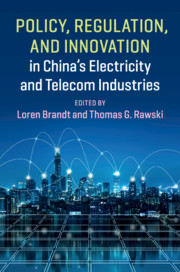Book contents
- Policy, Regulation, and Innovation in China’s Electricity and Telecom Industries
- Policy, Regulation, and Innovation in China’s Electricity and Telecom Industries
- Copyright page
- Contents
- Figures
- Tables
- Contributors
- Acknowledgments
- Abbreviations
- Map of China
- 1 Policy, Regulation, and Innovation in China’s Electricity and Telecom Industries
- 2 China’s Electricity and Communications Regulation in Global Context
- 3 Local Government and Firm Innovation in China’s Clean Energy Sector
- 4 Technology Integration in China’s Electricity System: Central Targets and Local Challenges
- 5 When Global Technology Meets Local Standards
- 6 The Search for High Power in China: State Grid Corporation of China
- 7 Growth, Upgrading, and Limited Catch-Up in China’s Semiconductor Industry
- 8 Growth, Upgrading, and Excess Cost in China’s Electric Power Sector
- 9 China’s Development of Wind and Solar Power
- 10 Capability Upgrading and Catch-Up in Civil Nuclear Power: The Case of China
- Index
- References
5 - When Global Technology Meets Local Standards
Reassessing China’s Communications Policy in the Age of Platform Innovation
Published online by Cambridge University Press: 08 June 2019
- Policy, Regulation, and Innovation in China’s Electricity and Telecom Industries
- Policy, Regulation, and Innovation in China’s Electricity and Telecom Industries
- Copyright page
- Contents
- Figures
- Tables
- Contributors
- Acknowledgments
- Abbreviations
- Map of China
- 1 Policy, Regulation, and Innovation in China’s Electricity and Telecom Industries
- 2 China’s Electricity and Communications Regulation in Global Context
- 3 Local Government and Firm Innovation in China’s Clean Energy Sector
- 4 Technology Integration in China’s Electricity System: Central Targets and Local Challenges
- 5 When Global Technology Meets Local Standards
- 6 The Search for High Power in China: State Grid Corporation of China
- 7 Growth, Upgrading, and Limited Catch-Up in China’s Semiconductor Industry
- 8 Growth, Upgrading, and Excess Cost in China’s Electric Power Sector
- 9 China’s Development of Wind and Solar Power
- 10 Capability Upgrading and Catch-Up in Civil Nuclear Power: The Case of China
- Index
- References
Summary
This paper uses the case of China’s mobile telecom industry to illustrate the challenges of pursuing national industrial policy objectives in the context of a highly dynamic and interconnected global industry. The Chinese state deployed a full arsenal of industrial policy tools in its effort to develop a Chinese modem telecom standard (TD-SCDMA) and support the development of domestic firms, yet success has been elusive. This outcome reflects the difficulty of creating a protected industry ecosystem for national firms in an industry that is increasingly dominated by global platforms. The outcome also reflects the rapid rate of change in the industry. While the state was using command-and-control methods to foster the development of core interconnect technologies, the locus of competition in the sector shifted closer to the consumer: toward handset operating systems, applications, and mobile services such as WeChat. The interconnect standards and technologies that had been the focus of China’s industrial policies are now largely generic and take up only the first few layers of handset architecture, and even handsets have become near-generic portals to on-line content, platforms and services. The Chinese firms that have thrived in this environment benefited from the protection provided by China’s Great Firewall, but are not otherwise a direct product of state support. They are entrepreneurial firms that understand the local market, and have been able to build novel solutions on top of global technology platforms. Their products and services may not be the “big” innovations that state planners often favor — services rather than semiconductors, for example — but these firms are highly competitive and have tremendous leverage within the huge Chinese domestic market.
Keywords
- Type
- Chapter
- Information
- Publisher: Cambridge University PressPrint publication year: 2019
References
- 11
- Cited by

